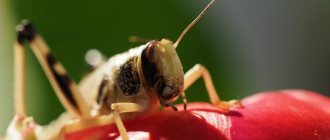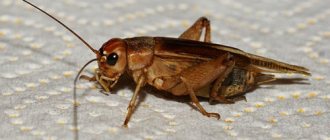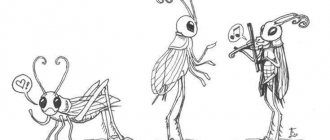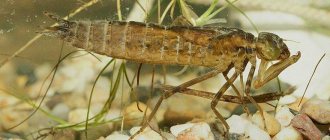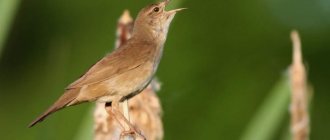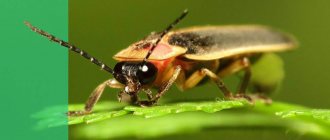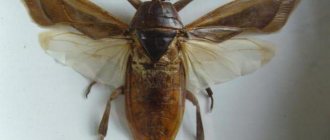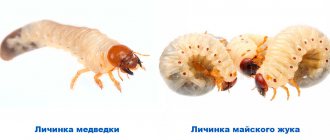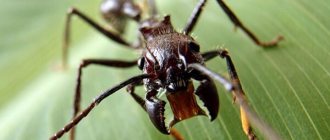- Where do insect musicians live?
- Interesting facts about crickets Signs of a cricket in the house
- Home insectarium
- Why is a cricket in the house dangerous?
A cricket in the house is not as disgusting as, for example, a cockroach, but it can be no less annoying. The Greeks called this insect, chirping at night and arousing curiosity, a singer. The cricket is considered a domestic insect, with many positive signs associated with it. Psychologists even advise listening to the chirping of a cricket, as well as the purring of a cat, to calm the psyche.
Where do insect musicians live?
Crickets have lived on Earth for 300 million years. It is believed that they settled around the world from the Far East and North Africa.
In summer, they often live outdoors in obliquely dug burrows at a depth of 10-30 cm, and when cold weather sets in, the cricket prefers to live in the house, behind the stove or behind the radiator. They settle on farms, climb into heating plants, and live in the basements of apartment buildings and warehouses.
For houses, they prefer old buildings with cracks, high humidity and old rugs. The settled guests do not disappear even after the house is rebuilt or renovated.
“A cheerful company sits behind the stove and, humming a song, moves its mustache!”
Half a century ago, there was a very popular song about four inseparable cockroaches and a cricket living behind an old man’s stove. What did the poor grandfather do to get rid of the annoying tenants! But nothing helped. He even blew up his stove with dynamite at the end of the song. But that didn't help either. According to the author of the hit of the last century, an inseparable company sat on a pile of stones and joyfully greeted their neighbor.
The song is a song, but it is also based on some facts. And questions naturally arise in my head. Why did this company not please the elderly man? And why did the cricket suddenly become friends with cockroaches? Let's try to find answers to them.
Interesting facts about crickets
The number of cricket species is 3,700, of which 30 live in Russia, but only a few are capable of living in human housing.
In the old days, the Chinese and Japanese spared no expense for the singing house cricket, which they entered into competitions.
Previously, crickets did not live in America; insects were brought there by European settlers.
When a cricket goes around the property at night or has a snack, the entrance to the “house” is covered with grass.
North American fishermen fish with crickets, and some Asians eat them.
Signs for a cricket in the house
People have long believed that a cricket in the house is a messenger of goodness, happiness and good luck. It drives away evil forces, brings recovery, and for a pregnant woman - an easy birth and health for the child.
The owners of the house with the cricket live in prosperity and prosperity.
Fights for territory
Cricket is a very modest “tenant”. Apart from the song, he does not betray his presence in any way. As a rule, only one cricket always sings in a home. This is a male, the strongest in this territory. The females are voiceless, and the remaining adult males are expelled. Between the contenders for the role of “boss,” fights to the death take place - insects mercilessly torment each other, tearing off paws, wings and whiskers, and the winner often eats the loser.
The most serious injury is considered to be the loss of the mustache. With one mustache, the male still continues to defend himself and even has a chance of winning, but remaining without a mustache, he hastily leaves the battlefield. He loses his status as a breeder and will end his short life as an outcast, not being seen by his relatives.
The Chinese, Malays and other Asian peoples use crickets' penchant for fighting for entertainment - insect fights in the East are no less popular than dog fights. In order to heat up the six-legged gladiators, it is enough to place a female next to them - the battle between the “suitors” will begin at that very second. The champion is awarded a comfortable cage, an exquisite menu and a harem of the most well-fed crickets. His offspring will be worth a lot of money.
An interesting way is how cricket owners raise the “morale” of their pets. The defeated and despondent male is simply thrown into the air, thus forcing him to spread his wings and fly. He won't fly far, but he will become noticeably more cheerful. The method has been known since the time of the Chinese emperors, but only recently have physiologists discovered its mechanism. During flight, crickets produce the “hormone of fearlessness” - octopamine, which makes the male combat-ready again.
Appearance of a cricket
The body of the cricket is strong, 1.6-2.6 cm long, at the end there are 2 strong and flexible processes that stick out to the sides. Three dark transverse stripes are visible on the oval head, and bulging eyes are visible on the sides. The mouth is equipped with a gnawing apparatus.
In addition to the eyes and mouth, the head of the cricket is equipped with long mustaches, longer than the body. This is the organ with which the insect touches and instantly senses danger.
Chitin body coating for reliable protection. On top of the body are elytra, from under which folded wings are visible, similar to a sharp tail. With the help of their wings, crickets easily fly over long distances.
The stronger back pair of legs has thickened thighs. These legs help crickets jump far. On the front legs there are “ears”.
Are they eaten?
In southern Asia, including Cambodia, Laos, Thailand, Vietnam, insects are eaten as a snack made by deep-frying soaked and cleaned insects.
Cricket flour is used as an additive in consumer products such as pasta, bread, crackers, and cookies. Flour is used in protein bars, pet food, livestock, and industrial purposes.
They are bred as food for zoo carnivores, laboratory animals, and domestic animals.
They have a high protein and calcium content. Every 100 grams of insects you eat will provide 13 grams of protein and 76 milligrams of calcium.
How are house crickets different?
Crickets are similar in appearance, except for color, to grasshoppers, but with a strong body. Both of them chirp at night.
Street or field crickets love to visit warm houses, but prefer their own burrows. These shy insects are black, dark brown or coffee brown in color. Straw-fawn or yellow-grayish crickets are also found. The thighs and spots near the elytra are orange. Habitat: steppes and forest-steppes.
House crickets choose to live in multi-storey residential buildings and cottages. This species is not so shy. Body color is gray-yellow, black or with brown tints. Stains or stains are visible on the body.
Chirping sounds are made by males to attract females. The first sounds are for luring, then - persuasion with serenades, after which - warning rivals. Sounds are made by the elytra, similar to playing with a bow.
How does a cricket live in the house?
As the temperature drops to 17 degrees Celsius, the crickets fall into torpor. To live and reproduce, insects move to warm rooms where the temperature is more than 25 degrees Celsius.
During the day, the jumping musicians are not visible; they sit out in corners and crevices. In cool summers, warm units of shops, bakeries and boiler rooms are chosen for habitat. Crickets are nocturnal travelers and give themselves away by making sounds.
There is a regular fight between the males for the boundaries of the territory, so they walk around their own possessions every night. A meeting with a stranger ends in a brutal fight, which is accompanied by mutual biting off body parts or eating the one who turns out to be weaker. Some hobbyists even raise these insects for cricket fights.
House crickets are omnivorous insects; they love both animal and plant foods. When settling in a house, crickets eat crumbs, leftover human food, and waste, preferring in liquid form. They hunt ants, cockroaches and flies, and does not refuse to eat moths. Crickets are cannibals; they eat rivals, eggs laid by the female, and young nymphs.
Home insectarium
Crickets are insects that are able to live and reproduce in captivity. Crickets are bred to feed birds and reptiles, to listen to their chirping sounds, or to keep as a substitute for pets. They are bred in industrial quantities for gourmets and lovers of original dishes.
Are they useful or harmful?
Crickets are often used:
- as bait for fishing;
- as food for exotic spiders or captive reptiles.
Insects are quite easy to breed. It is necessary to maintain a sufficiently high temperature (about + 30 ℃), supplement the lighting of the insectarium and add plant and protein products to the diet.
In Asian countries, crickets are traditionally used as food, usually fried or dried, as these creatures are rich in complete proteins.
In Japan, some crickets are kept in small cages as pets. The owners listen to their songs with pleasure.
Cricket matches have been played in China for a thousand years. Since wagering is prohibited, fighting is considered illegal.
Interesting fact! In some US states, snacks similar to crickets are sold: flavored, onion, dill, etc.
Stem crickets (blower crickets), when present in large numbers, can cause damage to vineyards and tobacco plantations.
How Do House Crickets Reproduce?
One male cricket takes care of 5-6 females, keeping competitors away. Reproduction occurs year-round, but these insects mate more often in warm weather, and after preliminary “dances.”
Using a long ovipositor, piercing the ground, the female cricket lays clutches of 30 eggs. At 30 degrees Celsius, the productivity of white elongated eggs increases. The female house cricket lays one or a bunch of eggs, hiding them in crevices.
The timing of maturation of the larvae in the egg is affected by the ambient temperature. More often, nymphs emerge after 1-2 months. Outwardly, they look like adult crickets, but in order to turn into a mature insect, they have to molt 9-10 times in 1.5-2 months.
At first, the juveniles stay in a flock, hiding in secluded places. They scatter into their own burrows after the third moult. After overwintering, they crawl out, and at this time the last molt takes place. After this, the cricket lives for 1.5 months. The life of tropical crickets is 5 months longer.
Songs and weddings
The cricket is nocturnal, like all long-whiskered orthoptera. As the sun sets, the roulades of the males are heard. To the untrained ear they all seem the same, but in fact there are at least three types of trills: dull and short ones frighten competitors, more sonorous ones attract females, and the highest and longest ones serve to declare love to the chosen one.
The cricket sings with its wings (and listens with its legs, since the hearing organs are located on the shins of the front legs). The musical instrument of these insects is structured as follows: on one of the elytra there is a thickened vein-“bow” with many regular teeth, and on the other there are several veins-“strings”. There are also “resonators”, that is, mirrors made of membranes. To make the instrument sound, the cricket raises its wing covers and moves them in a scissor-like manner. At the moment of fright, the insect slightly lowers its wings, but continues to sing - the sound is dull, coming from nowhere. This is how the cricket confuses its enemies.
Singing cricket
The Italian cricket (Oecanthus pellucens Scop.), a fragile insect with large translucent elytra, is particularly melodious. It was these singers who were kept in cages by the ancient Greeks. As a result of a translation error, crickets became known as “cicadas.” But a real cicada cannot survive in crowded conditions: it is very mobile and, unable to fly, dies. The songs of the four-spotted and banana crickets also have their fans, but the Chinese prefer to listen to the common field cricket. The older the male, the richer the sound of his instrument.
Crickets are picky brides. The gentleman persuades the female for several days, sings songs, drives away rivals and waltzes around the lady in a special dance. When he manages to win the beauty’s heart, he hangs a spermatophore (a special sac with seed material) from her abdomen and very quickly moves away. And for good reason. The fertilized female has a serious appetite and can attack the male as if he were prey.
After a certain time (from 2 to 7 days), the female lays eggs in the soil. For this purpose, a long ovipositor is used at the end of the abdomen, by which it can be unmistakably distinguished from a male. And after another two weeks, tiny larvae emerge to the surface. They have to molt from 4 to 6 times, depending on the species, in order to become adult insects capable of singing, fighting for territory and reproducing. In the meantime, their main task is to look for food and hide from enemies. The difference between adults and larvae is only in the size and strength of the jaws, but they eat the same thing. The babies' diet consists of tender shoots, berries and fruits, and a accidentally found pupa or clutch is considered a delicacy.
How to get rid of a cricket
Why is a cricket in the house dangerous?
The main thing is that it interferes with normal sleep. Harmful to exposed food and finishing materials. Insect waste products cause allergic reactions. But they rarely bite.
Where to look
Crickets love warmth, so they climb up where cold air does not reach or closer to heating appliances and the stove. Here it is worth covering up the cracks and blocking insects from accessing the hanging shelves. Crickets also like to hide in wet rags and paper, but their favorite place is the kitchen.
Methods of disposal
There are several options to drive away a cricket:
- catch with sticky traps or poison with alcohol vapor in a 2-level trap;
- treat the settlement areas with a decoction of wormwood, pyrethrum powder or Persian chamomile, fumigate with sealing wax smoke or use other folk methods;
- among chemical preparations, products with dichlorvos are most often used.
To destroy the offspring, repeat treatment is done. To prevent crickets from appearing, the kitchen should be cleaned more often and thoroughly, dried and ventilated.
Natural enemies
There are several enemies that eat crickets in the wild. They serve as food for birds, lizards, frogs and some spiders.
Recently, scientists discovered that insects are threatened by the spread of a parasitic organism in their populations: Nosemagrylli microsporidium.
Often the enemy of crickets is a person who wants to get rid of uninvited musicians.

